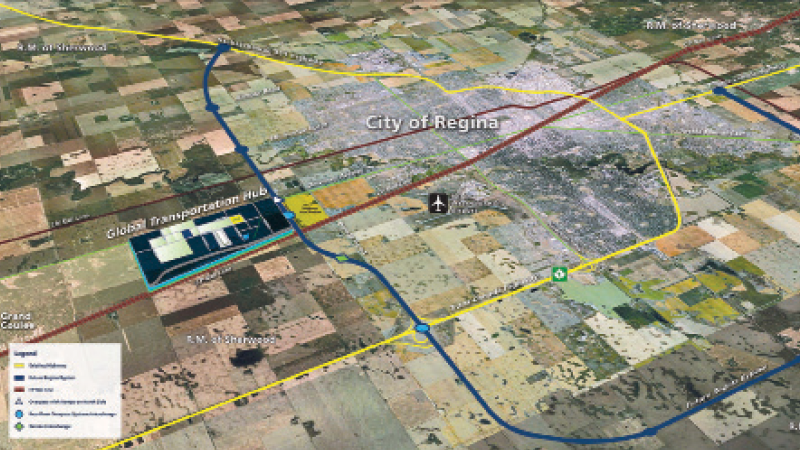The Global Transportation Hub (GTH) in Regina is fueling trade through world-class rail and highway infrastructure that assists companies in Canada’s most trade-reliant province (Saskatchewan) to realize logistical efficiencies in moving goods, thus saving them time and money. Centrally located between Canada’s largest seaports, the GTH is ideal for businesses requiring quick turnaround
and efficient transportation to markets across the globe. The GTH is western Canada’s newest, fastest-growing inland port authority boasting a strategic location, superior logistics, and cost-effectiveness.
In 2019, the GTH will celebrate its 10th anniversary as it was created by an Order-in-Council in 2009. However, President and CEO Bryan Richards tells WCHN, “It didn’t really get going until the end of 2011 and beginning of 2012 when Loblaw Companies Ltd. and Canadian Pacific Rail became tenants.” CP’s nearly completed intermodal facility anchors the GTH’s southern boundary, and connects to CP’s mainline, which connects to Vancouver, Toronto, Montreal, Gulf Coast and Great Lakes ports and Midwestern US trans-shipment points. The new intermodal yard has the capacity to expand to up to four times its current size to meet future demands.
Richards, who joined the GTH in August 2013, says he is happy with the progress to date, noting that $485 million in private investment has flowed into the GTH and some 4,800 trucks move through the inland port every week. He is looking forward to further growth in the future.
Location, location, location
The Asia-Pacific Corridor Initiative aims to build the world’s best transportation network for global supply chains between Asia and North America.
The Global Transportation Hub’s central proximity to major distribution points in North America has made it a key partner in this initiative. The GTH’s location also provides enhanced shipping efficiency from Asia to North America: Vancouver provides shorter shipping times to and from China than Los Angeles.
Saskatchewan is a critical link to the Asian Pacific Gateway and is the Port Metro Vancouver’s largest customer.
Why carriers should relocate to the GTH
According to Richards, “In conjunction with CP Rail’s intermodal facility, our extra-wide, double lane roadways are tailored to be easily accessible for even the longest combination vehicles, ensuring high volume and velocity of truck movements. We have access to two national highway system routes: the TransCanada Highway runs West and East between the Pacific and Atlantic Ocean coasts; and Highway 11 runs North and South and connects to the Yellowhead Highway. The GTH provides trucking connections to all major networks into the US and Mexico. In an environment where the movement of goods is timed to the minute, the GTH is designed specifically to meet the needs of heavy-haul transportation and logistics operations.”
He adds, “The clear benefit for carriers relocating to the GTH is efficiency. Our logistically superior operation offers carriers a huge opportunity to utilize timesaving infrastructure and be near their clients. We are home to three carriers with others currently looking to move in.”
As an autonomous and self-governing authority, the GTH oversees all stages of development and regulation. Carriers and other companies that locate to the GTH enjoy the organization’s streamlined approach that moves efficiently through development, permitting, and operations, maximizing a return on investment.
Regina Bypass to boost GTH’s profile
Currently under construction, the Regina Bypass is the largest transportation infrastructure project ever undertaken in Saskatchewan’s history. The need for a bypass was identified in the 1990s. Since then, six major studies and 38 supplemental studies have been undertaken. The eastern portion of the bypass is now open with one of the overpasses being put into use
20 months ahead of schedule. The western side of the Bypass, which includes access into the GTH, is slated to be finished in
the fall of 2019.
The Regina Bypass will improve a key component of the National Highway System.
- It will reduce traffic congestion in and around Regina.
- It will increase efficiency for truckers and shippers
moving goods. - Most importantly, it’ll improve motorists’ safety, including Trans-Canada Highway 1 east of Regina.
In total, the project consists of:
- 12 overpasses;
- 40 km of new four-lane highway;
- 20 km of resurfaced four-lane highway;
- 55 km of new service roads; and
- Twinning of about five km of Highway 6.
Asked what this will mean to the GTH, Richards succinctly states, “The Regina Bypass is a game changer for us. Free flow access to an interchange in all directions and access to the national highway system means carriers get to market faster, saving valuable minutes on every trip, and boosting their bottom lines. In short, it means everything!”
In the news
The GTH has been the unfortunate subject of controversy with some Saskatchewan media. According to Richards, the construction of the Regina Bypass, the largest construction project in the province’s history, necessitated the acquisition of land for the roadway connecting the GTH to the bypass more than five years ago. Speculation resulted in increased land prices and the GTH accused of paying too much for land.
A provincial audit was completed noting there was no conflict of interest or wrongdoing on behalf of the GTH, although the government admitted the process could have been handled better. Richards believes a review of the matter by RCMP will have a similar outcome as the audit.
Today and tomorrow
Asked for the GTH team’s current priorities, Richards replies it is twofold. “First, the completion of various infrastructure projects: the CP intermodal facility is done yet the benefits of the future $1.8 billion Regina Bypass project will not be fully realized for another year yet; that infrastructure represents key infrastructure to support free-flow access in and out of the GTH.” He adds that other internal infrastructure such as water & wastewater lines, service agreements, and other necessary items will ‘tick off as many boxes as possible’ for our current and future clients.
Second, Richards says we must play to the strengths of Saskatchewan. “For example, the area of agriculture is huge and multi-faceted. Saskatchewan is home to the ‘protein highway’ (an initiative to enhance cross-border collaboration among entrepreneurs, researchers and end users across the Canadian Prairies and US Midwest/Great Plains region) and we are in a unique position to get pulse crops to market. (Editor’s note: Pulses are very high in protein and fibre, while low in fat; the four main types of pulses grown in Canada are dry peas, lentils, beans and chickpeas.) As the research and market for this ag segment expands, we must be there to support it.”
As for the future, Richards says in the short-term the GTH “must take advantage of our new infrastructure and attract tenants to support Saskatchewan’s industries such as bringing value to agri-food industry.”
He concludes, “In the longer term, I’d like to see the ‘global’ aspect of our concept take effect with the growth of ‘cluster’ groups supporting various industries. This development will be a boon for both the GTH and Regina
and region.”


 1-866-985-9791
1-866-985-9791



